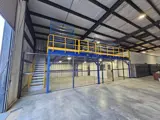Warehouse Safety Tips: Practical Strategies and Modular Solutions for a Safer Facility
Warehouses keep businesses moving — but they can also be among the most hazardous work environments. According to the National Safety Council, the transportation and warehousing sector experiences one of the highest rates of recordable injuries and illnesses in the United States. From slips and falls to forklift collisions and fire risks, maintaining safety and security in a warehouse requires proactive planning and continuous improvement.
At Panel Built, Inc., we help facilities create safer, more organized, and more efficient workspaces through modular construction. Whether you need better traffic flow, secure guard stations, or fire-rated inplant offices, our systems are designed to protect your people and your operations.
Below are six warehouse safety improvement ideas to help you reduce risk, improve morale, and strengthen your safety culture.
1. Train Your Team and Keep It Clean
The foundation of any warehouse protection plan is a well-trained workforce. Employees who understand proper procedures and recognize potential hazards are far less likely to make mistakes that lead to injuries.
Key training considerations:
- Provide onboarding safety orientation for new hires
- Conduct regular refresher training on forklift operation, PPE, and emergency response
- Reinforce accountability with visual reminders and posted safety rules for warehouses
Cleanliness is equally important. A tidy workspace reduces trip hazards and helps employees focus on their work. Encourage “clean-as-you-go” practices and implement scheduled housekeeping checks to keep walkways, storage areas, and loading zones clear.
2. Organize Smarter: Improve Layouts with Modular Mezzanines
A cluttered or poorly designed floor plan is a common source of warehouse injuries. Forklift collisions, blocked exits, and uneven traffic flow often trace back to inefficient use of space.
One effective solution is to go vertical. Modular mezzanines and catwalk systems make better use of overhead space, reducing congestion on the floor while improving visibility and workflow.
Benefits include:
- Additional storage or work zones without new construction
- Clearer pedestrian and equipment paths
- Enhanced safety compliance through better line-of-sight and organization
By optimizing your layout with modular solutions, you improve both safety and productivity.
3. Layer Physical Protection Around High-Risk Areas
In a fast-paced facility, even a momentary lapse in attention can lead to an accident. Installing physical barriers helps protect both employees and equipment by clearly defining safe zones.
Panel Built’s modular safety structures include:
- Steel barrier rails to guard machinery, racking, and walkways
- Guard rails that separate pedestrians from forklift traffic
- Safety swing gates for mezzanines and elevated work platforms
These modular systems are easy to install and reconfigure as your facility evolves, creating flexible, long-term safety infrastructure.
4. Fire Protection and Code Compliance
Fire is one of the most devastating risks in any industrial facility. Implementing proactive fire protection measures isn’t optional, it’s essential.
Panel Built’s fire-rated modular wall systems and inplant offices are engineered to meet strict safety standards and building codes. Options include:
- 1-hour fire-rated panels tested to ASTM E119 standards
- Class A fire-rated panels with low flame spread and smoke development
- Hybrid panels that balance cost and fire resistance for moderate-risk environments
These modular fire-rated offices provide both physical safety and peace of mind, allowing you to meet compliance requirements while maintaining flexibility in your layout.
5. Control Noise for Safer Communication
Excessive noise is more than a comfort issue, it’s a safety hazard. Constant loud environments can cause hearing damage and make it harder for workers to hear warnings, alarms, or verbal instructions.
Panel Built’s modular inplant offices and enclosures can be built with sound-dampening materials, such as Soundstop Board, to reduce ambient noise levels. This not only protects hearing but also enhances communication and concentration across the warehouse floor.
6. Strengthen Security and Access Control
Safety extends beyond internal operations—it also includes controlling who enters your facility. Unauthorized access can create risks for personnel, inventory, and sensitive equipment.
Panel Built’s security solutions include:
- Guard booths for monitoring entry and exit points
- Ballistic-rated guard houses for high-risk or high-value environments
- Access control integration for improved perimeter security
These structures help enforce safety protocols, protect employees, and deter theft or intrusion, ensuring that every part of your facility is secure.
Building a Culture of Safety with Modular Solutions
Every warehouse faces unique challenges, but one truth remains constant: proactive safety planning saves lives, reduces costs, and improves morale. By combining employee training with smart facility design and modular protection systems, you can create an environment where safety and productivity work together.
Create a Safer, More Productive Warehouse with Panel Built
At Panel Built, we believe safety isn’t just about compliance—it’s about protecting the people who keep your business moving. Our modular safety structures, inplant offices, and mezzanine systems are engineered to enhance protection, organization, and efficiency in any warehouse environment.
Call 1-800-636-3873, email info@panelbuilt.com, or request a quote online to start building a safer workspace today.





